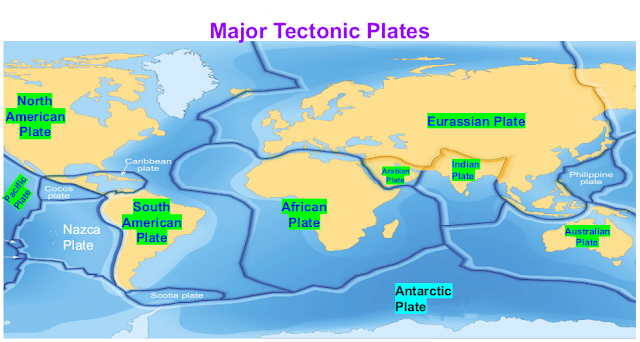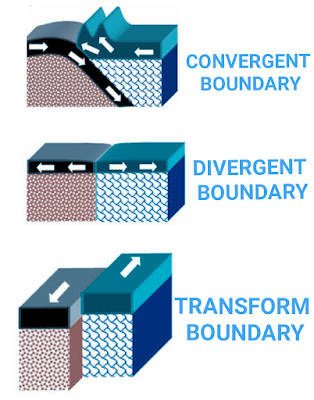CAUSES OF EARTHQUAKE
Seismic Sources are :
1) Natural Sources
These are :
Tectonic Earthquakes
Volcanic Earthquakes
Plutonic Earthquakes
Land slides
Collapse of Cavity
2) Man Made Sources
Some of the man-made activities that trigger earthquake are :
Chemical Explosives
Nuclear Explosives
Dam Construction
Mining Induced Earthquake
Cultural Noise (Industry, Traffic), etc.
Tectonic earthquake :
The sudden release of strain energy by rupture of the rock at plate boundry (fault plane) is the primary cause of seismic activity around the world.
About 90% of all earthquakes result from tectonic events.
Volcanic Earthquakes :
Shallow volcanic earthquakes may result from sudden shifting or movement of magma.
Plutonic Earthquakes :
Plutonic Earthquakes are caused by deep-seated changes.
Land slides :
Massive landslides associated with the volcanic activity produce significant ground motion.
Collapse of Cavity :
Collapse quakes can be triggered by such phenomena as cave-ins, mostly in karst areas or close to mining facilities, as a result of subsidence.
Plate Tectonics :
The convective current (flow) of the mantle material causes the crust and some portion of the mantle to slide on the hot molten outer core. This sliding of the earth’s mass takes place in portions called tectonic plates.
The surface of the earth consists of 12 major tectonic plates, 20 smaller tectonic plates and many filler plates. The major tectonic plates are the Indo Australian plate, the Eurasian plate, the African plate, the North American plate, the South American plate, the pacific plate, the Antarctic plate, etc.
These plates move in different directions and at different speeds relative to the neighboring plates at a rate of 5 to 10 cm per year on the plastic mantle. This movement is called plate tectonics. Sometimes, the plate in the front is slower, than, the plate behind it comes and collides and mountains are formed.
On the other hand, sometimes two plates move away from one another and rifts are formed. Sometimes, two plates move side by side, along the same direction or in opposite directions.
These three types inter-plate interactions are called the convergent, divergent and transform boundaries.
The Himalayas is the example of convergent boundary.
Earthquake epicentres are not evenly distributed over the surface of the earth, but occur predominantly in well defined narrow seismic zones that are often associated with volcanic activity.
These narrow zones are :
i) The circum pacific “ring of fire”
ii) The Alpine Himalayan belt well defined narrow seismic zones that are offen associated with volcanic activity.
iii) The world circling oceanic ridges.
These seismic zones subdivide the lithosphere laterally into 12 major tectonic plates.
EFFECTS OF EARTHQUAKE
Earthquakes are major hazards and can cause catastrophic damage. Their effects can be classified into two categories.
1. Primary effects
2. Secondary effects
1. Primary effects
Effects related with origin of earthquake are known as primary effects. Primary effects are directly connected with geology and topography.
Primary effects are :
i) Change in topography
ii) Formation of new hills
iii) Change in direction of existing water course
iv) Formation of new water course
v) Wrapping of strata
vi) Formation of sand dyke
vii) Formation of huge cracks in land
viii) Change in under ground water level
2) Secondary effects
Secondary effects are causzed due to passage of seismic waves and are associated with ground shaking.
Secondary effects are :
i) Destruction of human lives
ii) Destruction of multistoried buildings
iii) Destruction of dams and bridges
iv) Landslides and mudslides
v) Uprooting of trees
vi) Psychological effect on human beings.
vii) Worst effect on communication system
viii)Damage to roads and railway lines.
ix) Destruction of Telephone or T.V. tower
x) Huge waves in the sea (Tsunamis)
xi) Fire by damaging gas lines and snapping electric wires
xii) Rupture of dams and levees causing floods
xiii) Liquefaction of soil and sinking of structures


